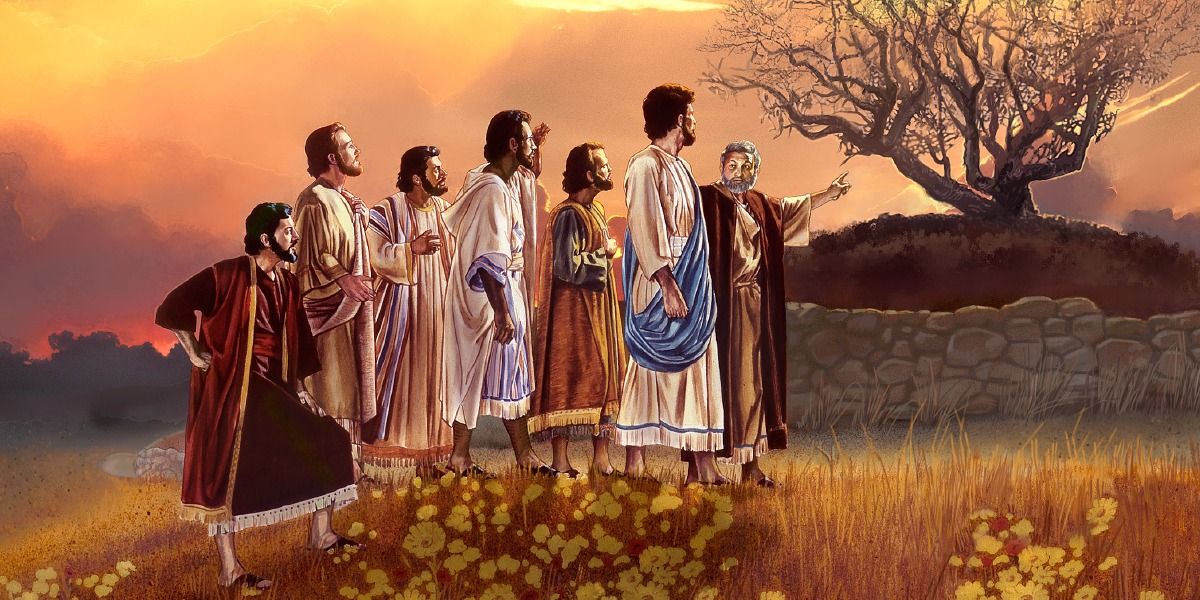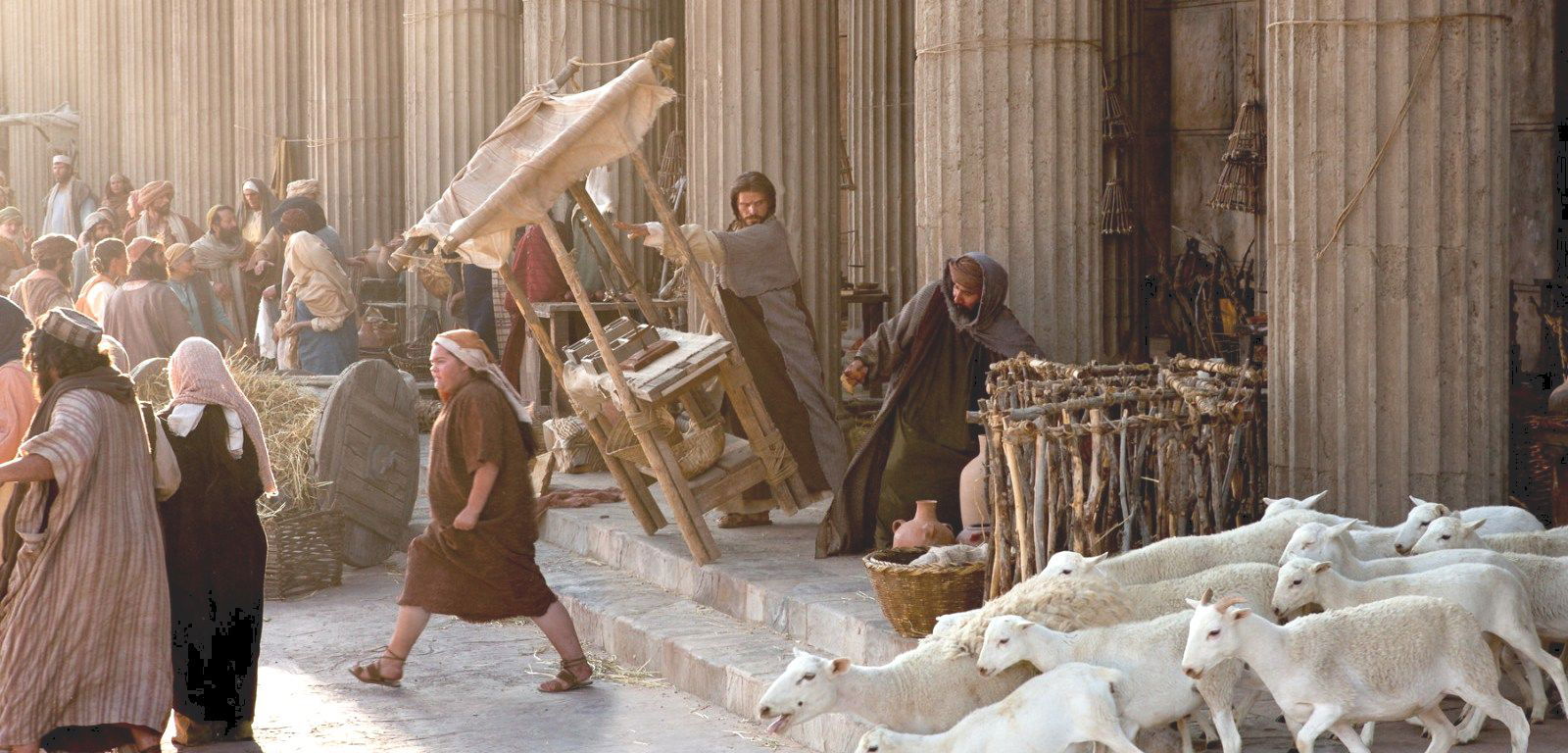EVENTS OF MONDAY, NISAN 11, 32 A.D.

Jesus Curses a Fig Tree
Jesus and His disciples left Bethany on Monday morning and made their way once again towards the city of Jerusalem. Somewhere between Bethany and the city of Jerusalem, Jesus found a fig tree that had no fruit on the tree and Jesus cursed the tree. His disciples heard Him when He cursed the tree.
In Matthew 21:18-19 we read…
Now in the morning [Monday, Nisan 11] as he returned into the city [Jerusalem], he hungered. And when he saw a fig tree in the way, he came to it, and found nothing thereon, but leaves only, and said unto it, Let no fruit grow on thee henceforward for ever.
In Mark 11:12-14 we read the following…
And on the morrow [Monday, Nisan 11], when they were come from Bethany, he was hungry: And seeing a fig tree afar off having leaves, he came, if haply he might find any thing thereon: and when he came to it, he found nothing but leaves; for the time of figs was not yet. And Jesus answered and said unto it, No man eat fruit of thee hereafter for ever. And his disciples heard it.

Jesus Cleanses the Temple
In Matthew 21:9-19 we read…
And Jesus went into the temple of God, and cast out all them that sold and bought in the temple, and overthrew the tables of the moneychangers, and the seats of them that sold doves, And said unto them, It is written, My house shall be called the house of prayer; but ye have made it a den of thieves.
And the blind and the lame came to him in the temple; and he healed them. And when the chief priests and scribes saw the wonderful things that he did, and the children crying in the temple, and saying, Hosanna to the Son of David; they were sore displeased, And said unto him, Hearest thou what these say? And Jesus saith unto them, Yea; have ye never read, Out of the mouth of babes and sucklings thou hast perfected praise?
In Mark 11:11-13 we read…
And they come to Jerusalem: and Jesus went into the temple, and began to cast out them that sold and bought in the temple, and overthrew the tables of the moneychangers, and the seats of them that sold doves; And would not suffer that any man should carry any vessel through the temple. And he taught, saying unto them, Is it not written, My house shall be called of all nations the house of prayer? but ye have made it a den of thieves.
And the scribes and chief priests heard it, and sought how they might destroy him: for they feared him, because all the people was astonished at his doctrine.
In Luke 19:45-46 we read…
And he went into the temple, and began to cast out them that sold therein, and them that bought; Saying unto them, It is written, My house is the house of prayer: but ye have made it a den of thieves.
In John 2:13-16 we read…
And the Jews' passover was at hand, and Jesus went up to Jerusalem, And found in the temple those that sold oxen and sheep and doves, and the changers of money sitting: And when he had made a scourge of small cords, he drove them all out of the temple, and the sheep, and the oxen; and poured out the changers' money, and overthrew the tables; And said unto them that sold doves, Take these things hence; make not my Father's house an house of merchandise.
WHY DID JESUS CURSE THE FIG TREE AND CLEANSE THE TEMPLE?
Jesus had just arrived in Jerusalem the day prior (Sunday, Nisan 10) with a great fanfare from the Jewish people, but then the following day He proceeds to curse a fig tree and to cleanse the Jewish Temple. -- Why? -- Because both events had significance as to the spiritual condition of the nation of Israel.
The unfruitful fig tree was symbolic of the nation of Israel, and Jesus was denouncing their spiritual unfruitfulness and their worship of God.
By cursing the fig tree, causing it to wither and die, and by cleansing the Jewish Temple, Jesus was pronouncing His coming judgment upon the nation of Israel during the coming Seven Year Tribulation Period and His power to carry out that judgment.
COMMENTARY ON JESUS CHRIST'S CLEANSING OF THE JEWISH TEMPLE
After reading all four Gospel accounts of the cleansing of the Temple there comes to mind the question…”Did all four accounts happen on the same day?”
A second question that comes to mind after reading the four Gospel accounts concerning the cleansing of the Temple by Jesus is … “Why do the accounts of Matthew and Mark appear to be in contradiction with one another?”--
Matthew’s account of the event appears to have happened on Palm Sunday, Nisan 10 and Mark’s account of the event appears to have happened on Monday, Nisan 11. The following quote helps to bring clarity to the above two questions…
[Begin Quote] - First realize that none of the Gospel accounts carries more than one Temple cleansing.
Logic tells us that if there were multiple cleansings, at least one of the gospel writers would have said so.
Second, none of the gospel writers set out to write a purely historical account. They all wrote to different audiences and sometimes they moved events around to help them make their point. [End quote] [1]
The following quote also helps to explain why the Matthew and Mark accounts of the Temple cleansing appear to conflict with each other. That is, Matthew’s account appearing to have happened on Palm Sunday, Nisan 10, and Mark’s account appearing to have happened on Monday, Nisan 11.
[Begin quote] – Competent scholars have long recognized that some accounts in the Scriptures are topically arranged at various points, rather than conforming to a strict chronological sequence. There is no conflict; there is merely a different purpose in the narratives. Many writers have noted that some portions of Matthew’s Gospel are arranged topically, rather than chronologically.
D.E. Hiebert observes: “The contents of Matthew, while revealing careful arrangement, are not readily arranged in a systematic outline. The arrangement of the material is largely topical." . .– [End quote]. [2]
Here is one more quote concerning the Matthew and Mark accounts being in conflict with each other…
[Begin quote] - When reading particularly the gospels, Bible scholars have long recognized that some accounts are topically arranged at some points, rather than conforming to a strict chronological sequence. This is because the gospel writers arranged their gospels to meet a particular need to the Christians they were writing to.
Gordon D. Fee and Douglas Stuart, in their book, How to Read the Bible for All Its Worth state:
"There were three principles at work in the composition of the gospels: selectivity, arrangement, and adaptation. On the one hand, the evangelist selected those narratives and teachings that suited their purposes…At the same time the evangelist and their church had special interests that also caused them to arrange and adapt what was selected.”
Regarding Matthew’s gospel they also state:
“As we study the narrative technique of Matthew in general, we find that he sometimes arranges his material in topical order rather than in the strictly chronological order that is more often characteristic of Mark and Luke.”
This is also confirmed by Henry C. Thiessen’s Introduction to the New Testament when he states,
“The first four chapters of Matthew are chronological; chs. 5-13 are topical; and chs. 14-28 are again chronological, with the exception of 21:18, 19 (p.138)”
With this in mind, please note that Matthew Gospel does not say that the cursing of the fig tree was on the day after the cleansing of the temple. He simply says that it was “Early in the morning, as Jesus was on his way back to the city (21:18).”
Secondly, Matthew combines the cursing of the tree and the discussion with the disciples without affirming that these events occurred on the same day.
In William Hendricksen’s commentary on Matthew, he writes:
“Since part of the Fig Tree story occurred on Monday and part on Tuesday (Mark 11:11,12,19,20), with the cleansing of the temple taking place (on Monday) between these two parts, it is clear that this story could be handled in two ways: (a) chronologically or; (b) topically.
Mark follows the first method, describing the first part of the Fig Tree story, the part that took place on Monday morning, in 11:12-14; then, the cleansing of the temple, later that same day, in 11:15-19; and finally, the second part of the Fig Tree story, the part that happened on Tuesday morning, in 11:20-24.
Matthew, on the other hand, uses the second method. He wishes to tell the entire story all at once, in one connected and uninterrupted account. In doing this he does not come into real conflict with Mark, for his (Matthew’s) time indications are very indefinite (p. 773).”
In short, Mark’s Gospel tells the fig tree story in chronological order while Matthew’s Gospel tells the story, but only in a topical sense.
Matthew 21:12-17 was an event that should not be taken to happen just prior to Matthew 21:18-22, because it was arranged topically, not chronologically as in Mark’s Gospel. No contradiction, just two different styles of writing to meet the audience need. [End quote]. [3]
Mark is the only apostle who mentions Jesus going into the Jewish Temple on Palm Sunday to look things over and then again on Monday, Nisan 11 to do the actual cleansing. Therefore I believe Mark’s account was relating to the day the event of the cleansing actually occurred.
In Mark 11:11 we see that after Jesus entered into Jerusalem on Sunday, Nisan 10, Mark states that Jesus looked over things in the Temple…
And Jesus entered into Jerusalem, and into the temple: and when he had looked round about upon all things…
Marks account for Monday, Nisan 11, is found in Mark 11:15-18 and reads as follows…
And they come to Jerusalem: and Jesus went into the temple, and began to cast out them that sold and bought in the temple, and overthrew the tables of the moneychangers, and the seats of them that sold doves; And would not suffer that any man should carry any vessel through the temple. And he taught, saying unto them, Is it not written, My house shall be called of all nations the house of prayer? but ye have made it a den of thieves. And the scribes and chief priests heard it, and sought how they might destroy him: for they feared him, because all the people was astonished at his doctrine.
When the evening of Monday, Nisan 11 comes, Jesus leaves the city of Jerusalem for Bethany. In Mark 11:19 we read…
“And when even was come, he went out of the city”.
This appears to have concluded the major events that occurred on Monday, Nisan 11.
Footnotes
[1] Kelly, Jack; “One Temple Cleansing or Two?”; https://gracethrufaith.com/ask-a-bible-teacher/one-temple-cleansing-or-two/; visited 4/06/2016
[2] Jackson, Wayne; “The Fig Tree Incident—A Contradiction”; https://www.christiancourier.com/articles/790-fig-tree-incident-a-contradiction-the; visited 4/06/2016
[3] Oakes, John; “Why is the order of events surrounding the cursing of the fig tree different in Matthew and Mark?”; http://evidenceforchristianity.org/why-is-the-order-of-events-surrounding-the-cursing-of-the-fig-tree-different-in-matthew-and-mark/; visited 4/06/2016